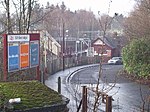St Ninian's High School, Giffnock
1984 establishments in ScotlandCatholic secondary schools in East RenfrewshireEducational institutions established in 1984Giffnock

St Ninian's High School is a six-year co-educational Roman Catholic state high school in Giffnock, East Renfrewshire, Scotland. The school, which opened in 1984, serves Giffnock, Clarkston, Thornliebank, Newton Mearns, Eaglesham, Netherlee, Waterfoot, Netherplace, Millhall and Busby in East Renfrewshire. The school roll was 1,714 as of September 2005, and the Head Teacher is Gerry O’Neil. The school's motto is "Floreat Iuventus" which translates as "Let youth Flourish".
Excerpt from the Wikipedia article St Ninian's High School, Giffnock (License: CC BY-SA 3.0, Authors, Images).St Ninian's High School, Giffnock
Rouken Glen Road,
Geographical coordinates (GPS) Address Phone number External links Nearby Places Show on map
Geographical coordinates (GPS)
| Latitude | Longitude |
|---|---|
| N 55.79949 ° | E -4.30213 ° |
Address
St Ninian's High School
Rouken Glen Road
G46 6UX , Lower Whitecraigs
Scotland, United Kingdom
Open on Google Maps









